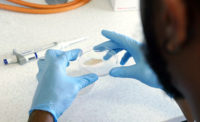Should Nuts and Low-Moisture Foods Consider a New Sampling Approach?

Credit: Kafeel Ahmed (kafeel) via Pexels
A pervasive trend exists to take larger and more frequent samples to address microbial contamination. This trend has touched almonds and is expected to hit other nut products. Various low-moisture powders have been shown to be very heterogeneous with regard to pathogen contamination. If experience holds true, then increased sample size and increasing numbers of samples will only marginally improve the situation, providing a superficially satisfying solution until it no longer satisfies. All food safety practitioners know that the underlying problems will be solved only by process and practice changes. It is impossible to test safety into a product. In the meantime, and to assist in the development and implementation of these improvements, perhaps it is time to invest in an improved sampling approach.
Other industries are exploring aggregated sampling, an approach to sample the surface of larger amounts of product to effectively increase sample size and achieve better representation in fewer samples. This patented technique has been promoted by Tommy Wheeler, Ph.D., and Terrance Arthur, Ph.D., two U.S. Department of Agriculture Agricultural Research Service (USDA ARS) researchers at Clay Center in Nebraska. USDA has officially recognized an aggregated sampling technique for beef trim. Its use has been growing for the past several years under a letter of no objection, with plant-by-plant validation. This approach is spreading to poultry and pork.
The produce industry is also exploring the technique in the face of outbreaks and market pressure to further reduce already low pathogen burdens. Researchers are investigating methods to apply aggregated sampling of the raw material in the field and during harvest. The Center for Produce Safety (CPS) has included aggregated sampling in the field as part of its request for proposals. One or more of these approaches may address the mounting pressure for more and larger samples.
The underlying science for aggregated sampling is not new. The importance of sampling where the target organisms are located has long been recognized. It is well acknowledged that sampling must be broad enough to be representative. Stomaching of samples evolved from a desire to sample the surface of products more effectively than by simply homogenizing the entire product. The practice of aggregated sampling has recently become more feasible and is becoming more accepted with the availability of sterile swabs of non-woven fabric that are appropriate for food contact. These swabs are used in two modes. They can be manually rubbed over the surface of the product when the product is stationary, as in a tote or bin. Alternatively, they can be positioned so that the product makes contact as it moves through the system, such as on a conveyor. The swabs are conventionally attached to a dead plate at a 45-degree angle, where the product will continue to fall for further conveyance or collection. The latter mode has the greatest power for improving the representativeness of the sample due to the increased product contact.
The almond industry can consider whether aggregated sampling would provide better information for managing Salmonella, a notorious pathogen that causes recalls in almonds and other low-moisture foods. Salmonella contamination of almonds is largely a surface problem because the interior of intact almonds is bacteria-free. Salmonella contamination in almonds is sporadic and probably clustered, making grab sampling less effective and tedious. Aggregated sampling can address these challenges. Investigative research is underway to assess the prominence of Salmonella in the pecan industry. It is reasonable to expect other nut products to be pushed in the same direction as the marketplace recognizes the potential hazards. The higher resolution of aggregated sampling would be expected to assist in assessing the impact of process and practice changes, given the already low background levels in this product category.
Many low-moisture foods can be considered for aggregated sampling. Ready-to-eat foods and foods that are consumed without a lethality step may benefit the most from aggregated sampling. Two products that can be used to illustrate the aggregated sampling method are powdered milk and flour. Powdered milk has a high probability of being consumed without further processing. It can be consumed directly or used as an ingredient. Dried milk powder (including infant formula) has occasionally been implicated in outbreaks associated with Salmonella, Cronobacter, and other pathogenic bacteria. The presence of these bacteria is usually the result of post-process contamination. Aggregated sampling can be part of the solution if the contamination happens between the spray dryer and the final packaging. If the contamination occurs later, then one would question the utility of aggregated sampling. Of course, there is no validation of aggregated sampling on powdered milk, so research is needed before applying the sampling method.
Flour is a second example. Flour is described as a "raw food" by the U.S. Food and Drug Administration (FDA). It may not look like a raw food, but it usually is, just like fresh tomatoes or carrots. The grains from which flour is ground are grown in fields and, like all foods grown outdoors, they may be exposed to a variety of harmful bacteria like Salmonella and pathogenic Escherichia coli. It is reasonable to expect that the bacteria were present on the outside of the wheat. It is, therefore, possible that surface contact with the flour might sample the target bacteria. However, again, validation does not exist for this process.
In summary, aggregated sampling is a tool that can help increase food safety by improving sample representativeness. However, food safety practitioners must be careful. It is said that to the person with a hammer, all problems tend to look like nails. Aggregated sampling is not the solution to all food safety challenges. It is a tool to make better assessment when the product attributes align with the promises delivered by aggregated sampling.
Looking for a reprint of this article?
From high-res PDFs to custom plaques, order your copy today!






